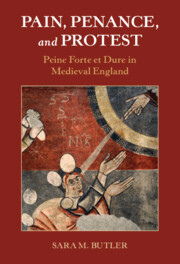Book contents
- Pain, Penance, and Protest
- Studies in Legal History
- Pain, Penance, and Protest
- Copyright page
- Contents
- Tables
- Acknowledgments
- Table of Statutes
- Abbreviations
- Introduction
- 1 Peine Forte et Dure: The Medieval Practice
- 2 Standing Mute in the Courts of Medieval England
- 3 Due Process and Consent to Jury Trial
- 4 Peine Forte et Dure as Barbarity? Putting the Practice in Context
- 5 Why Stand Mute?
- 6 Standing Mute as Imitatio Christi
- 7 Rejecting the Jury, Rejecting the Common Law, Rejecting the King
- Conclusion
- Bibliography
- Index
3 - Due Process and Consent to Jury Trial
Published online by Cambridge University Press: 19 November 2021
- Pain, Penance, and Protest
- Studies in Legal History
- Pain, Penance, and Protest
- Copyright page
- Contents
- Tables
- Acknowledgments
- Table of Statutes
- Abbreviations
- Introduction
- 1 Peine Forte et Dure: The Medieval Practice
- 2 Standing Mute in the Courts of Medieval England
- 3 Due Process and Consent to Jury Trial
- 4 Peine Forte et Dure as Barbarity? Putting the Practice in Context
- 5 Why Stand Mute?
- 6 Standing Mute as Imitatio Christi
- 7 Rejecting the Jury, Rejecting the Common Law, Rejecting the King
- Conclusion
- Bibliography
- Index
Summary
Consent is the issue at the heart of Chapter 3. Peine forte et dure was necessary simply because the English court system required a defendant’s consent before he might be submitted to trial by jury. Without his consent, justices could not proceed to trial. This chapter asks why did English justices see consent as vital, especially when other Europeans did not? It explains that consent was a traditional part of English legal culture, signaled by a defendant’s choice of proofs (compurgation, ordeals, battle). In choosing a method of proof, an accused felon recognized the court’s authority in the matter, and consented to abide by its decision. With the transition from proofs to trial (by jury) that began under Henry II and coalesced with Lateran IV’s abandonment of the ordeal, a defendant’s rights were whittled away. These changes took place against the backdrop of the twelfth-century legal revolution that championed a defendant’s natural rights to legal protection. Thus, while the English may have protested the loss of choice through silence, justices needed a solution that respected both English heritage and a defendant’s rights. That solution was peine forte et dure.
- Type
- Chapter
- Information
- Pain, Penance, and ProtestPeine Forte et Dure in Medieval England, pp. 134 - 187Publisher: Cambridge University PressPrint publication year: 2021



